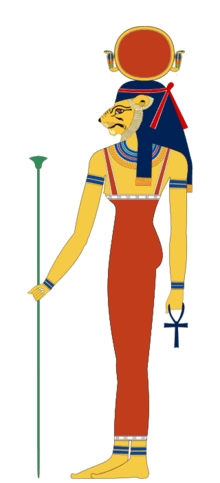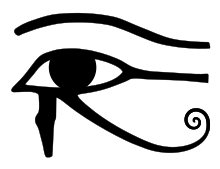Tefnut
Tefnut (Ancient Egyptian: tfnwt) is a deity of moisture, moist air, dew and rain in Ancient Egyptian religion.[1] She is the sister and consort of the air god Shu and the mother of Geb and Nut. She was known as Tphenis to the ancient Greeks.
| Tefnut | |||||
|---|---|---|---|---|---|
 The goddess Tefnut portrayed as a woman, with the head of a lioness and a sun disc resting on her head. | |||||
| Name in hieroglyphs | |||||
| Major cult center | Heliopolis, Leontopolis | ||||
| Symbol | Lioness | ||||
| Personal information | |||||
| Parents | Ra or Atum and Iusaaset | ||||
| Siblings | Shu Hathor Maat | ||||
| Consort | Shu | ||||
| Offspring | Geb and Nut | ||||
Etymology
Literally translating as "That Water",[2] the name Tefnut has been linked to the verb 'tfn' meaning 'to spit'[3] and versions of the creation myth say that Ra (or Atum) spat her out and her name was written as a mouth spitting in late texts.[4]
Like most Egyptian deities, including her brother, Tefnut has no single ideograph or symbol. Her name in hieroglyphics consists of four single phonogram symbols t-f-n-t. Although the n phonogram is a representation of waves on the surface of water, it was never used as an ideogram or determinative for the word water (mw), or for anything associated with water.[5]
Mythological origins
| Part of a series on |
| Ancient Egyptian religion |
|---|
 |
|
Beliefs |
|
Practices
|
|
Deities (list) |
|
Locations |
|
Symbols and objects
|
|
Related religions
|
|
|
Tefnut is a daughter of the solar deity Ra-Atum. Married to her twin brother Shu, she is mother of Nut, the sky and Geb, the earth. Tefnut's grandchildren were Osiris, Isis, Set, Nephthys, and, in some versions, Horus the Elder. She was also the great-grandmother of Horus the Younger. Alongside her father, brother, children, grandchildren, and great-grandchild, she is a member of the Ennead of Heliopolis.
There are a number of variants to the myth of the creation of the twins Tefnut and Shu. In every version, Tefnut is the product of parthenogenesis, and all involve some variety of body fluid.
In the Heliopolitan creation myth, Atum sneezed to produce Tefnut and Shu.[6] Pyramid Text 527 says, "Atum was creative in that he proceeded to sneeze while in Heliopolis. And brother and sister were born - that is Shu and Tefnut."[7]
In some versions of this myth, Atum also spits out his saliva, which forms the act of procreation. This version contains a play on words, the tef sound which forms the first syllable of the name Tefnut also constitutes a word meaning "to spit" or "to expectorate".[7]
The Coffin Texts contain references to Shu being sneezed out by Atum from his nose, and Tefnut being spat out like saliva. The Bremner-Rind Papyrus and the Memphite Theology describe Atum as sneezing out saliva to form the twins.[8]
Iconography
Tefnut is a leonine deity, and appears as human with a lioness head when depicted as part of the Great Ennead of Heliopolis. The other frequent depiction is as a lioness, but Tefnut can also be depicted as fully human. In her fully or semi anthropomorphic form, she is depicted wearing a wig, topped either with a uraeus serpent, or a uraeus and solar disk, and she is sometimes depicted as a lion headed serpent. Her face is sometimes used in a double headed form with that of her brother Shu on collar counterpoises.[9]
During the 18th and 19th Dynasties, particularly during the Amarna period, Tefnut was depicted in human form wearing a low flat headdress, topped with sprouting plants. Akhenaten's mother, Tiye was depicted wearing a similar headdress, and identifying with Hathor-Tefnut. The iconic blue crown of Nefertiti is thought by archaeologist Joyce Tyldesley to be derived from Tiye's headdress, and may indicate that she was also identifying with Tefnut.[10]
Cult centres
Heliopolis and Leontopolis (now ell el-Muqdam) were the primary cult centres. At Heliopolis, Tefnut was one of the members of that city's great Ennead,[9] and is referred to in relation to the purification of the wabet (priest) as part of the temple rite. Here she had a sanctuary called the Lower Menset.[1]
I have ascended to you
with the Great One behind me
and [my] purity before me:
I have passed by Tefnut,
even while Tefnut was purifying me,and indeed I am a priest, the son of a priest in this temple."
— Papyrus Berlin 3055[11]
At Karnak, Tefnut formed part of the Ennead and was invoked in prayers for the health and wellbeing of the pharaoh.[12]
She was worshiped with Shu as a pair of lions in Leontopolis in the Nile Delta.[13]
Mythology
Tefnut was connected with other leonine goddesses as the Eye of Ra.[14] As a lioness she could display a wrathful aspect and is said to have escaped to Nubia in a rage, jealous of her grandchildren's higher worship. Only after receiving the title "honorable" from Thoth, did she return.[4] In the earlier Pyramid Texts she is said to produce pure waters from her vagina.[15]
References
- The Routledge Dictionary of Egyptian Gods and Goddesses, George Hart ISBN 0-415-34495-6
- Collier, Mark; Manley (1999). How to read Egyptian Hieroglyphs. Bill (Third impression ed.). London: British Museum Press. ISBN 0-7141-1910-5.
- "Tefnut". Henadology.
- The Complete Gods and Goddesses of Ancient Egypt, Wilkinson, page. 183 ISBN 0-500-05120-8
- Betro, Maria Carmela (1996). Hieroglyphics: The Writings of Ancient Egypt. Abbeville Press. pp. 163. ISBN 0-7892-0232-8.
- Hassan, Fekri A (1998). "5". In Lucy Goodison and Christine Morris (ed.). Ancient Goddesses. London: British Museum Press. p. 107. ISBN 0-7141-1761-7.
- Watterson, Barbara (2003). Gods of Ancient Egypt. Sutton Publishing. p. 27. ISBN 0-7509-3262-7.
- Pinch, Geraldine (2002). Handbook of Egyptian Mythology. ABC-CLIO. p. 63. ISBN 978-1-57607-242-4.
- Wilkinson, Richard H (2003). The Complete Gods and Goddesses of Ancient Egypt. Thames & Hudson. pp. 183. ISBN 0-500-05120-8.
- Tyldesley, Joyce (2005). Nefertiti: Egypt's Sun Queen (2nd ed.). Penguin UK. ISBN 978-0140258202. Retrieved 17 January 2016.
- Hays, H.M (2009). Nyord R, Kyolby A (ed.). "Between Identity and Agency in Ancient Egyptian Ritual". Leiden University Repository: Archaeopress: 15–30. hdl:1887/15716.
Rite 25 from Moret, Le Rituel de Cult, Paris 1902
Cite journal requires|journal=(help) - Meeks, Dimitri; Christine Favard-Meeks (1999). Daily Life of the Egyptian Gods. Pimlico. p. 128. ISBN 0-7126-6515-3.
- The Routledge Dictionary of Egyptian Gods and Goddesses, George Hart ISBN 0-415-34495-6,
- Watterson, Barbara (2003). Gods of Ancient Egypt. Sutton Publishing. ISBN 0-7509-3262-7.
- The Ancient Egyptian Pyramid Texts, trans R.O. Faulkner, line 2065 Utt. 685.
External links

